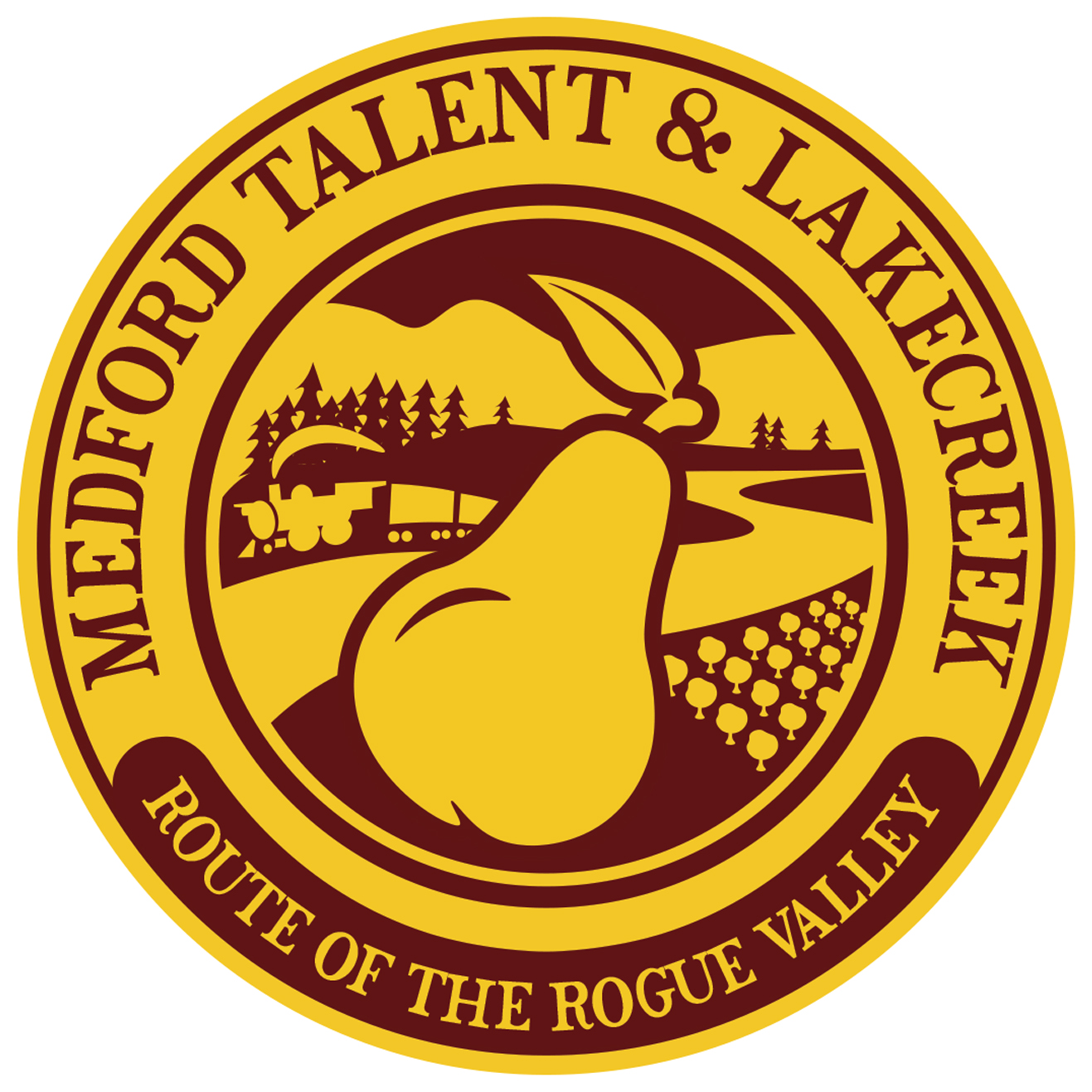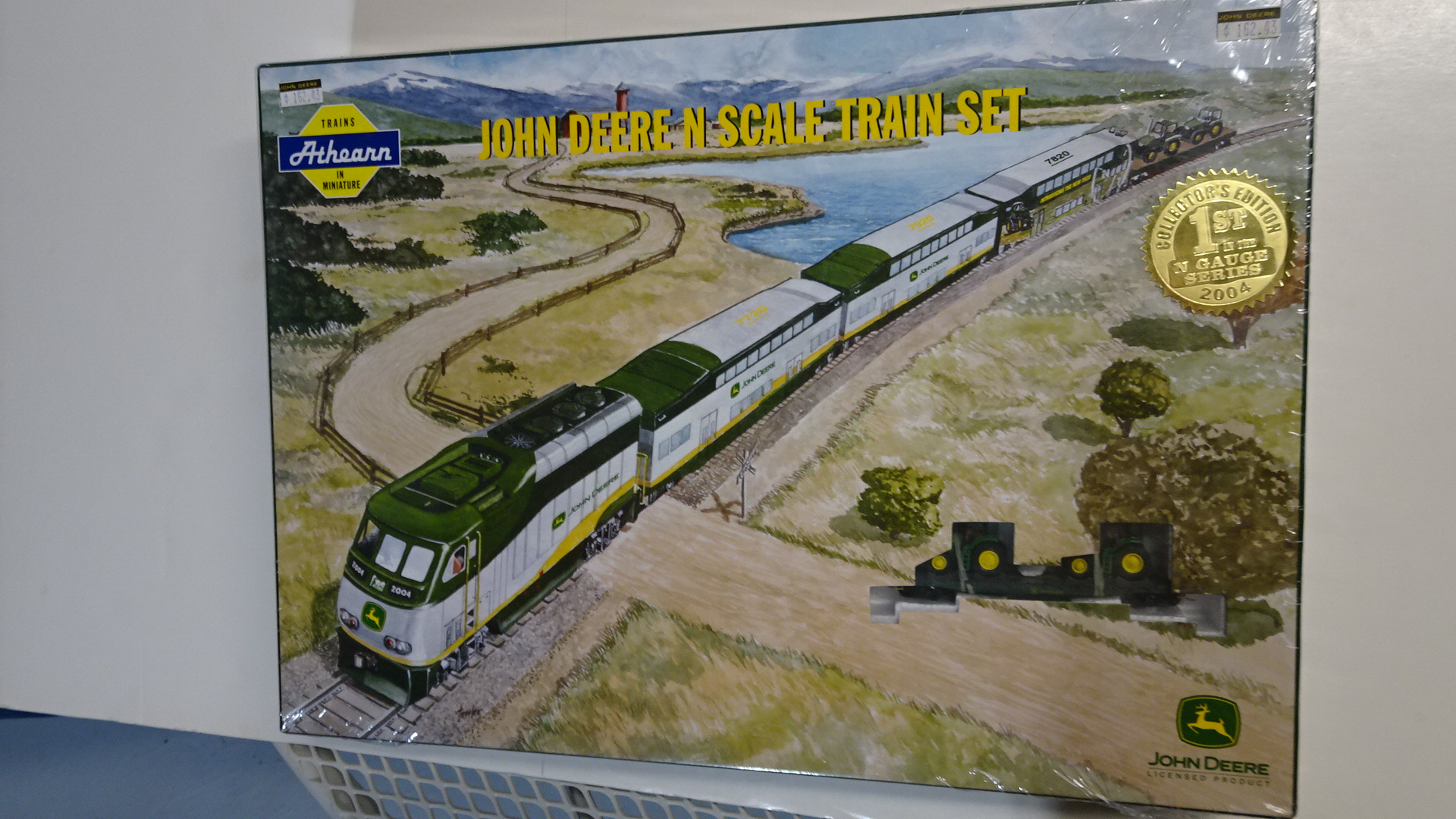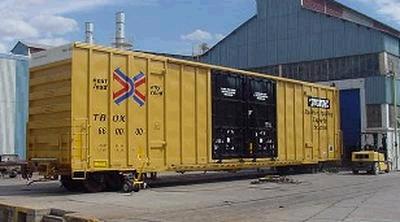Specific Item Information: Built in the 1970s, this high-cube boxcar was used to service various sheet metal and machinery manufacturing facilities throughout the Rogue Valley.
The Medford, Talent & Lakecreek Railroad was established in 1918 to serve the communities throughout Oregon’s Rogue Valley, helping move commodities to the Southern Pacific interchanges. The success of the modest shortline revolved around serving various agricultural, timber, and manufacturing industries, as well as some passenger and tourist traffic in the region. Though the wineries and orchards were still highly successful, by the 1970s and 80s, manufacturing and industry continued to increase in scope, constituting an ever-larger percentage of rail traffic in local trains. This necessitated infrastructure upgrades, and new railcars to be built to replace the aging rolling-stock from the 1940s and 50s.
Model Information: This body style models a Boxcar, 60 Foot, Riveted Side, Double Plug Door, High Cube.
Prototype History: The modern 100 ton, high-cube, 60’ boxcar has become ubiquitous in the modern rail scene. These cars are designed to carry a myriad of loads, from auto parts to forest products. This 60 foot box car design was produced by Gunderson, Incorporated, now part of the Greenbrier Companies from the early 1970s into the 2000s.
60’ Heavy Duty Plate C Boxcar:
Designed for the can manufacturing industry, this 100-ton boxcar has two heavy-duty movable bulkheads and one standard moveable bulkhead for convenient loading of aluminum stock. Other features include end-of-car cushioning and 80,000-pound smooth steel flooring. All door type configurations are available.
60’ High Cube Plate E Boxcar:
This 100-ton boxcar has smooth interior walls with recessed lading strap anchors. Extra strength at the side-to-floor connections and the door frame makes this an ideal car for loading and unloading heavy paper rolls. All door type configurations are available.
60’ High Cube Plate F Boxcar - Auto Parts:
Designed for the auto parts industry, this 100-ton boxcar has 18-inch end-of-car cushioning, removable rub rails and a volume of 7,580 cubic feet, making it ideal for carrying auto parts and other high-volume products. All door type configurations are available.
60’ High Cube Plate F Boxcar - Forest Products:
Greenbrier designed and built this 100-ton boxcar with 15-inch end-of-car cushioning and removable rub rails for carrying forest products. All door type configurations are available.
60’ Heavy Duty Plate C Boxcar:
Designed for the can manufacturing industry, this 100-ton boxcar has two heavy-duty movable bulkheads and one standard moveable bulkhead for convenient loading of aluminum stock. Other features include end-of-car cushioning and 80,000-pound smooth steel flooring. All door type configurations are available.
60’ High Cube Plate E Boxcar:
This 100-ton boxcar has smooth interior walls with recessed lading strap anchors. Extra strength at the side-to-floor connections and the door frame makes this an ideal car for loading and unloading heavy paper rolls. All door type configurations are available.
60’ High Cube Plate F Boxcar - Auto Parts:
Designed for the auto parts industry, this 100-ton boxcar has 18-inch end-of-car cushioning, removable rub rails and a volume of 7,580 cubic feet, making it ideal for carrying auto parts and other high-volume products. All door type configurations are available.
60’ High Cube Plate F Boxcar - Forest Products:
Greenbrier designed and built this 100-ton boxcar with 15-inch end-of-car cushioning and removable rub rails for carrying forest products. All door type configurations are available.
Road Name History:  The Medford, Talent and Lake Creek Railroad was established in 1918 to help local Rogue Valley communities move commodities to the Southern Pacific interchanges. The success of the model shortline in the early days brought not only commercial interest,s but tourist traffic to the region. The lush agricultural landscape, moderate climate and natural wonders of the Rogue Valley proved a great draw and helped establish the MT&L RR as a healthy regional line in Southern Oregon by the mid 20th Century. While most of the traffic supported the local fisheries, growers and fruit processors, the timber brought down through Lake Creek from the western flanks of the surrounding Cascades insured success for the fledging rail line.
The Medford, Talent and Lake Creek Railroad was established in 1918 to help local Rogue Valley communities move commodities to the Southern Pacific interchanges. The success of the model shortline in the early days brought not only commercial interest,s but tourist traffic to the region. The lush agricultural landscape, moderate climate and natural wonders of the Rogue Valley proved a great draw and helped establish the MT&L RR as a healthy regional line in Southern Oregon by the mid 20th Century. While most of the traffic supported the local fisheries, growers and fruit processors, the timber brought down through Lake Creek from the western flanks of the surrounding Cascades insured success for the fledging rail line.
By 1927 the numbers doubled as did the daily traffic of coaches and private parlor cars through the windy passage along the banks of the Upper Rogue River. In 1929 track was completed to the coast following the Lower Rogue to Gold Beach which provided a necessarly link to small communities delivering commodities and mail. With the completion of the link, the Rogue Valley flourished as did the MT&L RR enabling both to survive the coming Depression and Beyond. Source: Micro-Trains Line

By 1927 the numbers doubled as did the daily traffic of coaches and private parlor cars through the windy passage along the banks of the Upper Rogue River. In 1929 track was completed to the coast following the Lower Rogue to Gold Beach which provided a necessarly link to small communities delivering commodities and mail. With the completion of the link, the Rogue Valley flourished as did the MT&L RR enabling both to survive the coming Depression and Beyond. Source: Micro-Trains Line
Brand/Importer Information: Micro-Trains is the brand name used by both Kadee Quality Products and Micro-Trains Line. For a history of the relationship between the brand and the two companies, please consult our Micro-Trains Collector's Guide.
Manufacturer Information:  Micro-Trains Line split off from Kadee Quality Products in 1990. Kadee Quality Products originally got involved in N-Scale by producing a scaled-down version of their successful HO Magne-Matic knuckle coupler system. This coupler was superior to the ubiquitous 'Rapido' style coupler due to two primary factors: superior realistic appearance and the ability to automatically uncouple when stopped over a magnet embedded in a section of track. The success of these couplers in N-Scale quickly translated to the production of trucks, wheels and in 1972 a release of ready-to-run box cars.
Micro-Trains Line split off from Kadee Quality Products in 1990. Kadee Quality Products originally got involved in N-Scale by producing a scaled-down version of their successful HO Magne-Matic knuckle coupler system. This coupler was superior to the ubiquitous 'Rapido' style coupler due to two primary factors: superior realistic appearance and the ability to automatically uncouple when stopped over a magnet embedded in a section of track. The success of these couplers in N-Scale quickly translated to the production of trucks, wheels and in 1972 a release of ready-to-run box cars.
Micro-Trains Line Co. split off from Kadee in 1990 to form a completely independent company. For this reason, products from this company can appear with labels from both enterprises. Due to the nature of production idiosyncrasies and various random factors, the rolling stock from Micro-Trains can have all sorts of interesting variations in both their packaging as well as the products themselves. When acquiring an MTL product it is very important to understand these important production variations that can greatly enhance (or decrease) the value of your purchase.
Please consult our Micro-Trains Collector's Guide

Micro-Trains Line Co. split off from Kadee in 1990 to form a completely independent company. For this reason, products from this company can appear with labels from both enterprises. Due to the nature of production idiosyncrasies and various random factors, the rolling stock from Micro-Trains can have all sorts of interesting variations in both their packaging as well as the products themselves. When acquiring an MTL product it is very important to understand these important production variations that can greatly enhance (or decrease) the value of your purchase.
Please consult our Micro-Trains Collector's Guide
Item created by: grothe77 on 2023-10-17 23:36:36. Last edited by grothe77 on 2023-10-30 15:03:41
If you see errors or missing data in this entry, please feel free to log in and edit it. Anyone with a Gmail account can log in instantly.
If you see errors or missing data in this entry, please feel free to log in and edit it. Anyone with a Gmail account can log in instantly.









